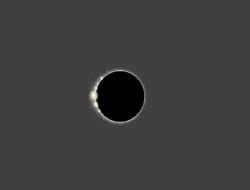 |
Bailey's Beads |
You may have heard that there is a Solar Eclipse today. This is a very interesting kind of eclipse.
As you remember, solar eclipses occur when the Moon gets between us and the Sun. When this happens the shadow of the Moon makes a small spot on the Earth roughly 100 miles in diameter. As the Moon goes around the Earth and the Earth/Moon goes around the Sun, the shadow spot moves in a line across the Earth. Only if you are lucky enough to be on that line will you see the total eclipse.
It is totally by accident that the apparent size of the Moon and the Sun are the same to us here on Earth so that when the Moon lines up with the Sun in a Total Eclipse, the Moon just fits over the face of the Sun. Well, usually it just fits. Since the Moon doesn't travel in a perfect circle about the Earth, sometimes the Moon is just a bit farther away and, hence, looks just a little smaller. Of course, the Earth/Moon also doesn't travel in a perfect circle about the Sun either. We are just a little closer in December/January than June/July. (Yup, we are closer to the Sun during our winter!) With all this variability in distance to the Moon and to the Sun, sometimes we get an eclipse when the Moon covers the Sun but we can still see a tiny bit of the face of the Sun (the photosphere) peaking though the valleys of the mountain ranges on the "edge" on the Moon! This is called an Annular (ring) Eclipse and the bright "diamonds" of sunlight ringing the Moon are called Bailey's Beads, after the British astronomer Francis Bailey who recorded seeing them during and annular eclipse in 1836.
Today's eclipse isn't an annular or a total eclipse; it's both! Today's eclipse is a very rare event called a hybrid. The eclipse starts out as (just barely) an annular eclipse. As the spot of the Moon's shadow slides across the Earth, because of the curvature of the Earth and the movement of the Moon, half way along the "path of totality", the Moon becomes just big enough to cover the whole Sun and the eclipse is total. This eclipse path is long enough so that, since the Moon keeps moving and the Earth is curved, it is now moving a bit farther away from shadow spot on the Earth and, at the end of the "path of totality", the Moon is no longer big enough to cover the Sun and it is again an annular eclipse! This is truly and amazing and very rare event.
Hybrid eclipses happen about 6 times a century but they are almost always just total-to-annular or annular-to-total. Today's annular-total-annular eclipse is WAY more rare!
Check out: Hybrid Solar Eclipse of 2005 April 08